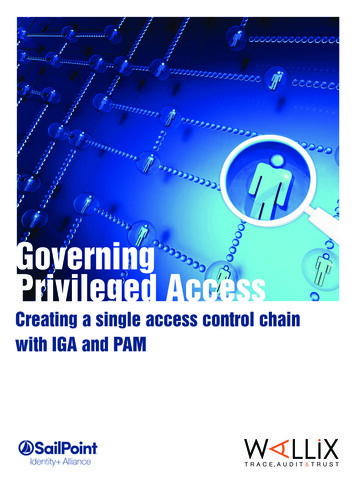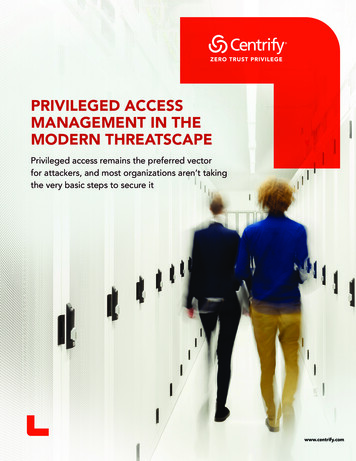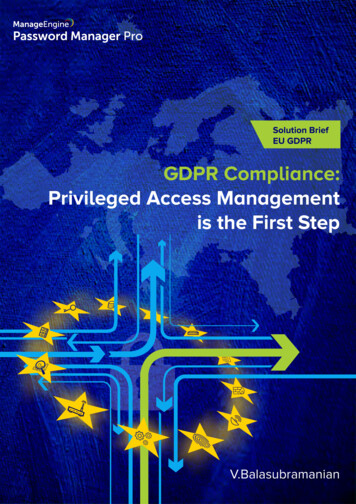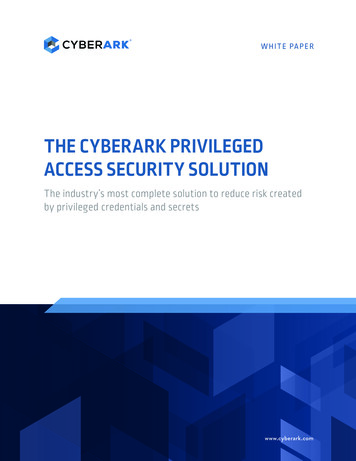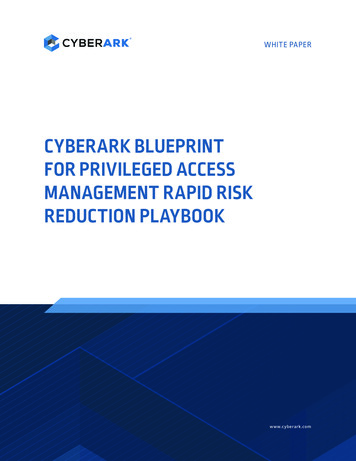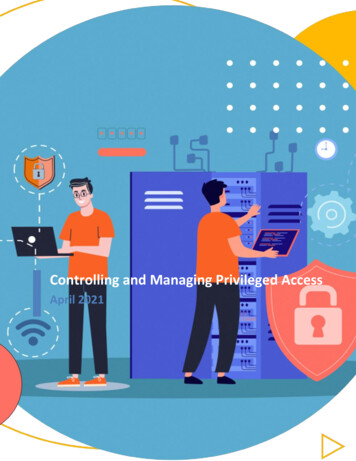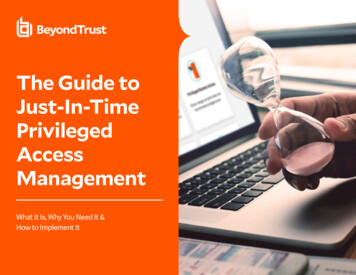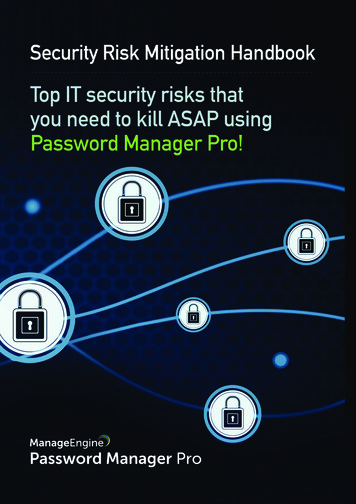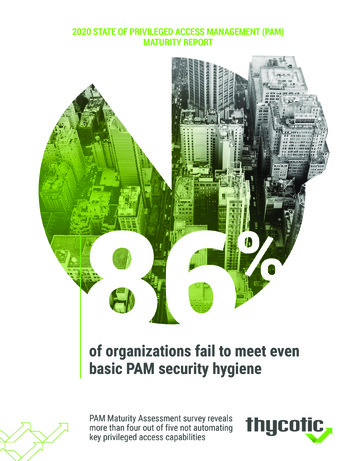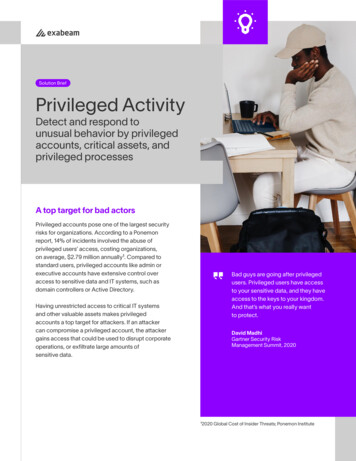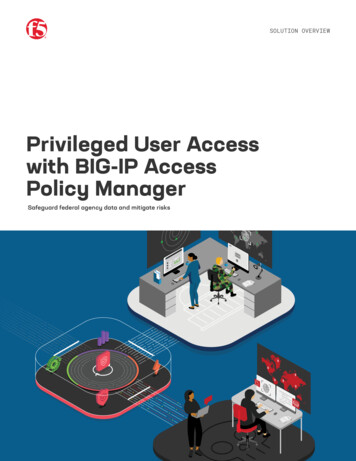
Transcription
W H I T E PA P E RControlling and ManagingPrivileged AccessA Primer on Privileged Access ManagementAbstractEffective management ofprivileged accounts (sometimescalled superuser accounts) andprivileged access is becomingmore and more critical. This isbecause security and complianceare driving forces behind most ITinitiatives and privileged rights arethe key – or downfall - to achieveboth security and compliance. Andin today’s complex, heterogeneousenvironments, native privilegedaccess management (PAM)tools and manual practices areinadequate.This white paper explores the risksassociated with privileged access,and explains how solutions fromOne Identity mitigate those riskswith granular access control andaccountability.This paper is intended for CIOs,IT directors and managers,security and compliance officers,and administrators, especiallythose who have not establishedfirm control over all of theirorganizations’ privileged useraccess.The challenges of privileged accountsPrivileged accounts are necessary but riskyPrivileged accounts (known as ‘root’ in the UNIX and ‘administrator’ in theWindows world) are necessary from an administrative perspective.Administrators need easy access to elevated and mission-critical IT assetsthat control the operation and function of the broader enterprise. Often, theonly way to get that access is to use privileged accounts.While operating systems have become significantly more powerful in recentyears, privileged access has not evolved as quickly. So a single, all-powerfullevel of access still exists in some enterprises. For instance, many UNIXadministrative tasks can’t be carried out without root access, and many ofthose tasks are quite routine. While a small business may have only a singletrusted person with privileged access, most midsize to large businesses havemultiple privileged administrators that all need access to the same privilegedcredentials.The problem is that operating systems do not natively offer a way todiscriminate more granular privileged access: it’s an all-or-nothingproposition. Therefore, a surprisingly large number of people can oftenwield incredible power within the native OS — much of which is unnecessaryfor each individual to fulfill his or her role. Since privileged accounts canbe used to bypass standard controls and authorization levels, a personwith a privileged account often has unlimited access and, if they becomedisgruntled, they can inflict significant damage to networks, servers,applications and data.The problem is not only that too many administrators have elevated access.It is that administrators can work outside the network’s identity managementsystem and hide their actions. In addition, countless organizations work withthird-party IT providers to help them operate their IT environment. In order todo this, these third-parties require remote access to privileged accounts andsensitive IT assets. When damage is done, most organizations face seriouschallenges in discovery and analysis of the bad behavior. They have problemsfinding out what went wrong, who did what and when they did it. This opensup a level of risk that has no place in a secure IT environment.Then there is compliance. Many organizations need to meet SOX, PCI DSS,HIPAAA, GDPR (and more) specifications, as well as local regulations. Theseregulations require organizations to control all access to sensitive information.Regulations and failed audits are becoming serious concerns for CIOs andw w w. o n e i d e n t i t y. c o m
CISOs, as auditors are paying closer attention to privilegedaccounts. Organizations must pass these audits as the directand indirect costs of non-compliance is much higher than theinvestment in supportive processes and technologies.The solution lies in a combination of policies, checks andbalances, automated oversight and analysis that can enablemore granular privileged access managementSolving your privileged accessmanagement challengesEstablishing checks and balancesIn the United States’ system of government, constitutionalchecks and balances assign separate powers to the judicialbranch, legislative branch and executive branch. Think of theexecutive branch (Office of the President) as the privilegedaccount holder; the president wields the ultimate access rightsand decision-making authority — but that power is mitigatedby the oversight of the other two branches. In an enterpriseenvironment, a similar system of checks and balances can beestablished to limit the power, authority and access rights ofprivileged users.In most cases, granting the ‘keys to the kingdom’ to a singleperson is not really necessary — the operating system’sprivileged account system does not have to be used as is. Amore granular delegation of authority, policy-based control,automated workflows and activity monitoring can add a layerof security to an inherently insecure designation, while stillenabling administrators to get their jobs done efficiently andeffectively.A surprisingly large numberof people have unlimitedprivileged access withinnative OS management tools— and much of this access isunnecessary for their role.Through a policy-driven implementation of these areas, anorganization can protect its data, prevent security breachesand ensure compliance with an ever-widening array ofrules. This is the realm of privileged access management: acombinationof processes, policies and technologies that ensure thatprivileged users and superusers who have access toadministrative credentials are doing the right things, that accessis delegated on an as needed basis and that an audit trail is keptin place at all times. In short, privileged access managementadds accountability back into what is otherwise a free-wheelingand overly broad system of administrative access.Managing privileged access: Who guards theguards?The fundamental challenge of access management is thatthe IT department is usually delegated the role of managingaccess, authentication and authorization — but often no oneimposes that control over the IT department. Those whohave privileged access may have a common ethos for sharinginformation (including passwords), self-policing their actionsand keeping that enhanced level of access to themselves. Butwho guards the guards?It’s all too common for enterprises to lack any coherent strategyfor privileged access. Most large organizations have multiple(internal or third-party) administrators, including Windows,UNIX and other administrators, each with his or her own tasksto complete. IT administrators have a culture of trust betweenthemselves, and it’s not unusual for multiple administrators toshare a single superuser password. This is a friendly way to dobusiness, but a risky one – and it’s unnecessary.IT people don’t always appreciate what management sees asessential: the need to impose strict controls over themselves.As a result, something exceedingly powerful — the unlimitedaccess that can be gained from privileged accounts — receiveslittle oversight and is too often protected by just a cobbledtogether, ad hoc, informal and frequently ignored set ofadministrative protocols. As a result, in any enterprise withmore than a handful of IT staff, a number of people will haveprivileged access, which allows them to do just about anythingthey wish.The basic challenges companies face with regard to privilegedaccess include: No accountability, since there is (amazingly) no oversight ormanagement system to control privileged accessAn optimal approach to privileged access management shouldinclude the following checks and balances: Privilege safe Command control and granular delegation Keystroke logging and session audit Entitlements and behavior analysis Too many people with access to superuser or root accounts,including admins with limited responsibilities but unlimitedaccess Lack of control over the privileged access password, whichis frequently shared Lack of detection and analytics capabilities related toprivilege misusew w w. o n e i d e n t i t y. c o m
Privileged access management is a combination of processes,policies and technologies that ensure that privileged users andsuperusers who share administrative credentials are doing theright things, that access is delegated on an as-needed basis andthat an audit trail is kept in place at all timesSafeguarding sensitive information andensuring complianceProtecting sensitive data and applications is a growing concernfor CIOs and senior IT management. Faced with a rapid growthin traffic and data volume, both small and large organizationshave a need for privileged users with broad access to servers.This naturally makes it difficult to protect data and comply withregulatory mandates.Controlling third-party vendor and consultantaccessTechnologies, such as cloud computing, along withglobalization and constantly changing economic conditions,have transformed the ways that enterprises conduct business.In particular, more organizations use third-party vendors andconsultants to acquire specialized solutions without adding fulltime IT staff.While this new business model brings many benefits, it alsocreates challenges, the greatest of which is secure access.Third-party specialists require access to the corporatenetwork, and in many cases, this must include a level ofprivileged access. Granting privileged access to people insidethe company brings enough problems; providing privilegedaccess to outside consultants, who are running computersthat your organization has not provisioned and that maynot be firewalled or protected from malware, is a disaster inwaiting. Making it worse, many times these providers employremote specialists completely unknown to the customer.And this raises further concerns of trust. Even a conservativesecurity policy would prohibit such access, but a strictprohibition would make it too difficult for contractors to getthe job done.The only good solution is to enable remote vendors with acontrolled and continuously monitored version of privilegedaccess, so that they can gain entry to those areas they trulyneed to access without being able to snoop around the entirenetwork looking at confidential corporate data assets.Disgruntled and terminated superusers have been knownto steal or sabotage data on their way out the door, andindustrial espionage occurs on a regular basis. Identity theftand theft of corporate secrets takes place more frequentlythan many people are aware, and it’s often an insider who isthe culprit.Such was the case at Nuance a speech-recognition softwarefirm in 2018 when 45,000 patient records hosted on one ofits medical transcription platforms were leaked. The leakcame at the hands of a former employee who hacked into thecompany’s servers to access the patient information.Another instance of insider threat arose in April of 2018 whena former employee of SunTrust Bank tried to pilfer the names,addresses, phone numbers and account balances of 1.5 millionbank clients. The malicious insider was attempting to providethe data to a criminal outside the organization but got caughtbefore it could be sent. The disaster was averted, but thesituation could just as easily have gone the other way.Privileged AccessAn alternative to giving administratorsunlimited access with no oversightClearly, administrators need to have access to do their jobs,but the ‘all or nothing’ approach native to the OS is inadequateand outdated. Most admins who have privileged access doindeed need privileged access to one or more areas of thenetwork, but it is unlikely that they require privileged access toeverything. What is needed is a way to allow easy, unfetteredaccess to resources when it is needed; to restrict access towhat is not needed. Such a system would: Delegate specific privileges to administrators based on role Include a policy engine that delegates access based onneed Provide a complete audit record with full details of accessand specific actions takenUnderstanding the risks: When things gowrongTraditional approaches to privileged accessmanagement are almost always inadequateThe risks of privileged accounts are not just theoretical.Motivating a group of IT people to adhere to a neww w w. o n e i d e n t i t y. c o m
management policy is a little like trying to herd cats. Uppermanagement often has a hard time trying to impose its point ofview over the IT department. Sometimes it just can’t be done.IT people are an independent-minded fraternity. Managing ITfrom outside the department is difficult because managementdoesn’t really understand everything that IT people do. Whenthe operations manager, or any manager from outside IT,steps in and announces, ‘We need to restrict your access,’ thatoutside person had better be armed with a very compellingargument and a firm resolve.Basic conflicts occur when management views privileged orunlimited access as a problem, while admins see it as standardoperating procedure. As a result, organizations tend to adoptone of three solutions: Issue a memo, which everybody understands will beuniformly ignored, but management has been placated. Implement a manual solution (often called a ‘firecall ID’) thatinvolves writing the privileged access password on paper,sealing it in an envelope and storing it in a secure, physicallocation (such as a safe) controlled by an outside trustedemployee or manager. That outside individual is tasked withchanging the password each time it has been used. Create individual solutions and policies that lack unification,solving only one problem at a time.The first approach above is clearly inadequate. The secondsolution attempts to address the issue, but because it isprimarily human-controlled, it is still subject to error, loss andintentional misuse. In addition, this approach breaks downwhen there are dozens or hundreds of accounts at hand.The third solution may be adequate in smaller companyenvironments. The open-source solution sudo, for example,solves a lot of problems and may be all that is needed if thereare only a handful of UNIX and Linux servers involved. But forlarger installations, sudo offers no centralized managementfunction to control multiple servers from a single managementconsole, nor does it provide an audit trail. (For more on sudo,see the section ‘The sudo project’ below.)Three basic policies are essential to successPreventing disasters like the Nuance and SunTrust incidentsdescribed above is not rocket science, but most companiessimply don’t do it. That rogue administrators were able tosteal data because their privileged access was not revokedimmediately upon his termination. An enforced policy of swiftlyrevoking the access of terminated individuals should be astandard policy of every company — and it’s not that hard toimplement. These organizations simply got bogged down inbureaucracy and unnecessary procedures, delaying pulling theplug on the administrator’s access until it was too late.These episodes could have been easily averted had theorganization created and enforced three simple policies: Limit the rights of administrators. Native UNIX takes an ‘allaccess’ approach to administrator permissions, violating thebasic premise that every security manager knows: ‘Trust noone.’ Granting administrators everything they need to dotheir jobs, but nothing beyond that, brings a new level oforder and common sense.The unlimited access that canbe gained from privilegedaccounts usually receiveslittle oversight and is toooften protected by just acobbled together, ad hoc,informal and frequentlyignored set of administrativeprotocols. Shut down access quickly when necessary. Some companiesphysically escort terminated employees and contractors offthe premises, and although being walked off the propertyby a security guard is decidedly embarrassing, it is anunfortunate necessity. A single employee with a grudge cancause a lot of damage if left alone for even a few minutes,especially if he or she has access to and knowledge of theIT system. Sound policy must allow HR to terminate allcomputer access just prior to the employee receiving notice. Track and analyze administrator activity. Many organizationshave a system to track what employees are doing, but thattracking often doesn’t extend to the superusers. Existingtechnology can record keystrokes and observe actions inreal time, create an audit trail and alert upper managementthat something is amiss before the damage is done. Andmany solutions can also save the session for forensicsanalysis and playback later.Of course, a comprehensive answer to the problems ofprivileged access goes beyond a single solution; it involves acombination of enforceable policy and the right mix of broadenterprise solutions and specific technology solutions designedto satisfy compliance requirements and close the potentialsecurity holes created by the existence of multiple privilegedaccess accounts.Admins are busy, so convenience factorsmatterAdmins are overworked, which is why they tend to takeshortcuts like writing privileged access passwords on paperw w w. o n e i d e n t i t y. c o m
and sharing them with one another. The idea of imposing awhole new protocol for privileged access will never get buy-inif it also imposes too many requirements that take extra time.For instance, the largely manual and labor-intensive ‘firecall ID’scenario can break down very quickly, and basic sudo doesn’twork beyond just a few servers. It’s too much extra work fora group of people that are already trying to pack 12 hours ofwork into a 10-hour day.Instead, management of privileged accounts must beautomated, role- based, easy to use, and centralized across allsystems with policies uniformly applied.Granular access: adopting the least- privilegemodelInstead of the universal access granted by privileged accounts,organizations need to be able to provide access on an asneeded basis, based on each individual’s specific role. This isthe principle of least privilege: provide access to only what isneeded, when it is needed. This is not available in the operatingsystem, but must be implemented with added privilegedaccount technology and supported by policy.Implications for regulatory complianceCompliance issues have impacted even the smallest businesseshard. Regulatory compliance requires businesses across allindustries to implement a secure environment that safeguardspersonal information and proves compliance with auditable records.Regardless of the particular piece of legislation with which abusiness needs to comply, privileged access is at the forefrontof the compliance paradigm. Most compliance issues can beaddressed, however, through separation of duties within theprivileged access domain, along with access control and auditcapabilities.The sudo projectNative sudoThe open-source sudo project has gone a long way towardsresolving privileged account challenges that many enterprisesface. Sudo solves the immediate problem of admins accessingmore than what they really need: it delegates authority andrestricts access based on each person’s role.The free sudo project may be adequate in somecircumstances. But for a larger enterprise with serioussecurity requirements, it might not go far enough. The biggestlimitation of sudo is that it is not possible to natively create asingle policy and apply and manage it universally across allservers and networks.Another limitation of sudo is that there is no audit trail andno visibility. Moreover, there is no centralized policy control,so management of the sudo environment is cumbersome andnot standardized between servers. Sudo is widely used and avery common solution, but not a complete one for enterpriseenvironments.With One Identity solutionsA set of products that work together tosolve your privileged access managementchallengesOne Identity’s approach to privileged account and accessmanagement is a set of independent products, that worktogether to solve the vexing problems associated withprivileged accounts.Ease of useOne Identity solutions deliver the advantages of a commonstandards-based approach, without the heavy requirementsand administrative burden required by an all-encompassing,‘big box’ approach. With solutions from One Identity,companies use only what they need, keeping costs down andeliminating unnecessary layers of administration.A privilege safe enables centralized andpolicy-based release of privileged accountcredentialsOne key function of One Identity’s advanced approachto account management is a ‘privilege safe.’ One IdentitySafeguard for Privileged Passwords allows for centralized andpolicy-based release of privileged account credentials, withoutlimitations from platforms, servers or devices — it works acrossthe board on everything. Safeguard for Privileged Passwordsreplaces the laborious, manual process of the ‘firecall ID’ withan appliance, making the process of password managementautomated, centralized and policy driven. Possession of thepassword can be set for a specific time or for a specific task,after which it is automatically revoked and changed.Safeguard for Privileged Passwords is also designed todeal with the passwords that are typically hard-codedinto applications. There may be dozens or hundreds ofadministrators who have, over time, learned those hard-codedpasswords — an obvious security risk. One Identity eliminatesthe need for hard-coded passwords; instead applications anddatabases are configured to make runtime calls to Safeguardfor Privileged Passwords. With this approach, nobody knowsthe application passwords, and the passwords can be changedrather than being locked into scripts, which is the real securityand compliance concern.Session management includes full keystrokelogging and moreThe ability to watch what people are doing is important toany system of checks and balances. One Identity Safeguardw w w. o n e i d e n t i t y. c o m
On-PremCredential Protectionand ManagementHybridSession Recordingand MonitoringThreat Analyticsand ResponseCloudLeast s DevOps Active DirectoryWindows UNIX Linux MacFigure 1. One Identity security solutions include comprehensive offerings that address the privileged accessmanagement needs of even the most diverse and demanding enterprises.for Privileged Sessions supports full keystroke logging withsearch capability. In addition to recording keystrokes andspecific commands, Safeguard for Privileged Sessions enablesmanagers to watch over things as they happen on the screenand play back recorded sessions like a movie after the fact.One Identity Safeguard for Privileged Sessions providesan extra layer of accountability and visibility, including theability to remotely kill a session or revoke access if needed. Inaddition, the chore of proving compliance or discovering thecause of trouble is bolstered by forensics-ready recording, fulltext search and playback of privileged access sessions.Analytics detects behavior anomalies withmachine learningOne Identity is committed to improving the sudo platform,first by employing Todd Miller, the maintainer of sudo, to helpkeep the project alive and move it forward, and by offering aseries of commercial enhancements. One Identity’s commercialsolution, Privilege Manager for Sudo picks up where sudoleaves off, providing more granular control over policy,enhanced monitoring and the ability to manage delegationacross multiple servers.One Identity’s first commercially released sudo plug-in is acentral policy server. In the past, one of sudo’s limitations wasthat it had to be managed individually on every server on whichsudo was installed, and there was no integration betweenservers. This led to a lot of redundancy and the need to rewriteidentical policies for each server. Now, with Privilege Managerfor Sudo, users can create policies from a single policy engineand push them out to everywhere they are needed.With Safeguard for Privileged Analytics, organizationscan know who their high-risk privileged users are, monitorquestionable behaviors and uncover previously unknownthreats from inside and outside of the organization. Byusing machine learning technology, Safeguard for PrivilegedAnalytics detects anomalies and ranks them based on risk, socompanies can prioritize and take appropriate action.Privileged delegationAttackers, who steal user credentials behave differently thanreal users. One Identity Safeguard for Privileged Analytics isable to detect the level of deviation from normal user activity.If the deviation is high, it sends an alert to the security team forfurther investigation. Suspicious activities can be confirmed bythe user to detect identify theft, which dramatically speeds upforensic investigation and decreases false positives.Privileged account management uses a system of delegationand control to limit what privileged users can and cannot do.Within UNIX and Linux environments One Identity offers areal-time, agent-based, granular delegation solution, PrivilegeManager for UNIX that runs on a server, providing bothwhitelist and blacklist capabilities and almost infinite controlover policies and policy enforcement.Plug-ins from One IdentityBeginning with version 1.8 (February 2011), sudo architectureallows anybody to write plug-ins and add functionality to sudo.The second sudo plug-in from One Identity is a keystrokelogging module, which adds an extra layer of visibility,accountability and auditability.Either option provides absolute control over policy creationand enforcement. Not only can responsibility be delegated,it can be delegated based on role and time. For example, anadministrator may be delegated specific privileges during theweek, but if they have different tasks on the weekend, theyw w w. o n e i d e n t i t y. c o m
can be assigned root access for that specific period of time orunder very specific circumstances.Appliance-based, host-based and agentbased optionsA variety of delivery options are available to match every typeof deployment need. Appliance-based solutions are extremelysecure, easy to implement and easy to manage; just plug in theappliance and it is hacker proof. Host-based solutions are supersecure, controllable and granular but slightly more expensive.Agent-based options deliver highly targeted, highly granulardelegation for UNIX, Linux and Active Directory.ConclusionThe problems that arise from uncontrolled access to privilegedaccounts can result in multi-million dollar losses. Fortunately,powerful, cost-effective solutions are readily available toprotect your business.One Identity’s suite of privileged access management solutionsgive you the comprehensive accountability, granular accesscontrol, monitoring and analytics that are missing from nativeoperating systems, delivering a framework of least privilegeso that administrators have access to what they need, but onlywhat they need at the time they need it.About One IdentityOne Identity helps organizations get identity and accessmanagement (IAM) right. With our unique combination ofofferings, including a portfolio of identity governance, accessmanagement, privileged management and identity as a servicesolutions, organizations can achieve their full potential –unimpeded by security, yet safeguarded against threats. Learnmore at OneIdentity.com 2019 One Identity LLC ALL RIGHTS RESERVED. One Identity, and the One Identity logo are trademarks and registered trademarks of One Identity LLC inthe U.S.A. and other countries. For a complete list of One Identity trademarks, please visit our website at www.oneidentity.com/legal. All other trademarks,servicemarks, registered trademarks, and registered servicemarks are the property of their respective owners.Whitepaper 2019 ControllingAndManagingPrivAccess US RS 38223w w w. o n e i d e n t i t y. c o m
in place at all times. In short, privileged access management adds accountability back into what is otherwise a free-wheeling and overly broad system of administrative access. Managing privileged access: Who guards the guards? The fundamental challenge of access management is that the IT department is usually delegated the role of managing
